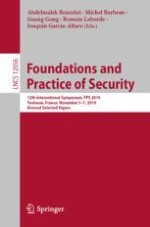2020 | Book
Foundations and Practice of Security
12th International Symposium, FPS 2019, Toulouse, France, November 5–7, 2019, Revised Selected Papers
Editors: Dr. Abdelmalek Benzekri, Prof. Michel Barbeau, Prof. Guang Gong, Dr. Romain Laborde, Joaquin Garcia-Alfaro
Publisher: Springer International Publishing
Book Series : Lecture Notes in Computer Science
